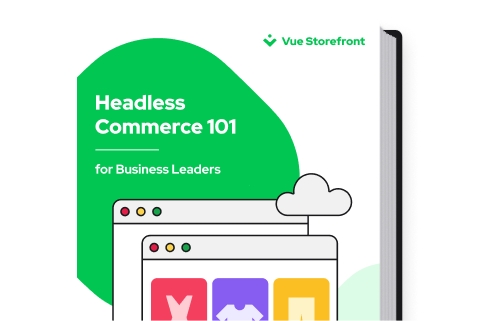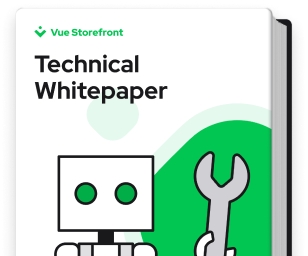Explore by Category:
Headless Commerce
Why Headless Commerce and Retail Go Hand in Hand
What do headless commerce and retail have in common? If you are a retailer, you’ve probably heard the term “headless” referring to commerce. The more popularity it gains, the more businesses wonder — what does it actually mean? And if it’s something useful, how can one take advantage of it?
The headless approach is worth digging into. It empowers businesses to stay on the bleeding edge of the market and get the upper hand in the competitive eCommerce landscape.
In this piece, we’ll cover what a headless approach is, what the benefits are and the challenges of going headless, and why it is the future of retail.
What is headless commerce?
Headless commerce is the kind of software architecture that is based on decoupling the backend and frontend layers into two independent entities. To understand this concept, let’s take a step back and take a look at monoliths first.
The monolith structure implies that the backend and frontend are tightly connected. Simply put, if you want to add an extra button on your website or adapt your store for a new platform (solely frontend changes), you’ll need to get your hands into the backend too.
Contrary to a monolith, a headless system has three core pillars:
- Backend aka business logic layer
- Frontend aka presentation layer
- API layer as a way of communication between the two above
In headless architecture, all your business functions can be supported by different tech vendors instead of an all-in-one monolithic solution. This allows retailers to deliver solutions ahead of market needs and significantly improve customer experience.
How do headless commerce and retail benefit each other?
The short answer is: headless transformation helps retailers beat the market and stay on top.
The modern retail market is fast-paced and highly competitive: yesterday it was desktop only, today customers are shopping through TikTok. The ability to swiftly make changes and adapt to new customer demands is crucial — otherwise, the effects will be felt on revenue.
The biggest issue with monoliths and traditional commerce is their bulkiness. Keeping your business tied up to the backend means a longer time to implement changes, bigger bugs and error risks, less adaptive designs, and overall more troubled performance.
Let’s look into the benefits of headless transformation closely.
What are the benefits of headless commerce for retailers?
With headless technology comes adaptability. And a lot of other benefits retail businesses can use to their advantage.
Improved performance and scalability
If done right, going headless results in higher website speed and a more seamless user experience. Leveraging the Progressive Web App technology and modern frameworks like JavaScript offers more optimized mobile versions. In this case, you:
- rank higher on Google, thanks to optimized mobile-first frontend and faster page load
- provide native experience on every platform due to PWA’s adaptive nature
- nurture conversion rates and cut losses in revenue
Such an approach also future-proofs your store. Whether you are a corporation or a small store, a headless approach ensures you won’t face issues when evolving into a new stage.
Improved customer experience
With fast page loads and the ability to quickly introduce changes to the presentation layer, you automatically regain control over the customer experience. As the entire customer journey happens on the frontend, you need to supercharge your headless commerce stack with a highly-performant and mobile-first frontend solution like Frontend as a Service .
Research shows that only a few milliseconds in site speed means millions of dollars on sales made or lost. Headless commerce architecture provides retailers with the ability to influence conversion rates and revenue.
Seamless omnichannel becomes real
The customer journey is not a straight line from your homepage to catalog to cart. Each new device or social media is a potential part of your omnichannel strategy.
When headless commerce and retail combine, omnichannel becomes real. Retailers can create adaptive interfaces for every touchpoint, plugging the new “head” seamlessly into the existing system.
Your store can launch a new platform, product line, or additional brand and create a responsible native interface for each within hours instead of months.
More space for customization
Your team gains almost unlimited control over the whole headless system. You can choose tech vendors and particular solutions for every business function based on what you need, rather than what your eCommerce platform offers.
It also brings you more versatile UX/UI opportunities. Since you’re not tied to the backend, the changes and tests take less time. Your team is free to implement the foremost tools and create a better customer experience — both design and usability-wise.
While monoliths usually offer page builders and templates, the headless API-first approach removes limitations. With the opportunity to cherry-pick the most suitable service and plug it into your system, you get to create exactly the kind of business you want.
Read more about the benefits of headless commerce .
What to consider before going headless
The shift from monolith to headless may be challenging. It takes time and resources, especially if you are about to break the monolith structure entirely. However, the outcome is surely worth it.
When it comes to online retailers and headless commerce, the approach to transformation depends on several factors:
- The size of your business
- Developer resources
- The level of customization
- Time & budget
- Current setup
Headless suits corporations and small businesses equally, but the resources and demands differ. Bigger companies running several stores often have more developers to build and maintain a very composable solution and opt for enterprise solutions. Smaller brands are tighter on budget and schedule, so they usually tend to opt for open-source headless solutions.
Luckily, headless architecture is very versatile and offers opportunities for any retailer on the market. It includes lots of solutions you can combine: headless commerce platforms, content management systems, payments, a decoupled frontend, etc. So before wiping the whole system clean, take a look at your current store: maybe some of your elements are already headless-friendly?
If your store runs on Shopify, Magento 2, SAP Commerce Cloud or another headless commerce platform that Alokai integrates with out-of-the-box, congratulations — you won’t need to re-platform fully. Add a highly performative frontend solution and a headless CMS to the mix, and this can be the initial map of your new headless commerce system.
Wrap-up
One of the most cost-efficient fast options for decapitating your frontend is a Frontend as a Service model (FEaaS). Retailers can use FEaaS to build, test, and host optimized and performant custom-built frontend using cloud-based modules. Alokai provides Frontend as a Service solution for swift and smooth headless transformation for retail.
Start your headless journey with Alokai. Download a short whitepaper and learn how it works.
Share:
Share:
More in Headless Commerce
Frequently asked questions
Ready to dive in? Schedule a demo
Get a live, personalised demo with one of our awesome product specialists.























